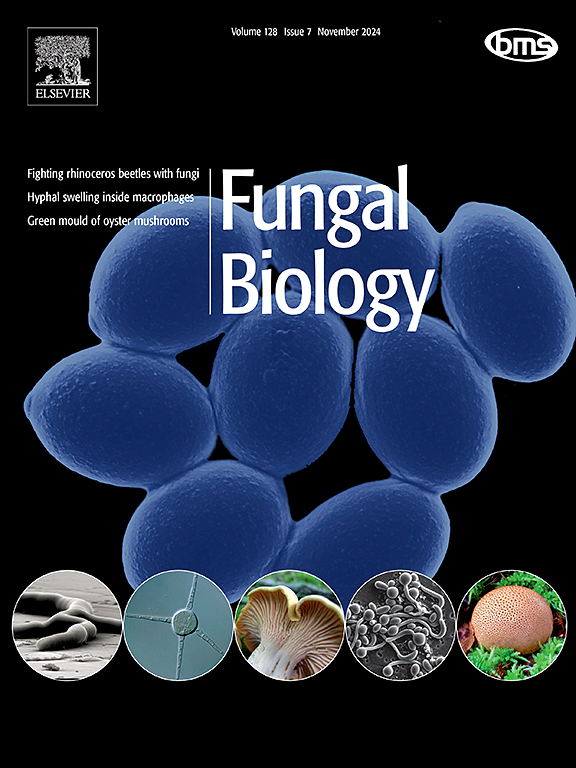Around the world in eight white rot species: Assessment of enzymatic and non-enzymatic wood decay pathways of worldwide Esca Complex of Diseases (ECD) associated basidiomycetes
IF 3
3区 生物学
Q2 MYCOLOGY
引用次数: 0
Abstract
Esca Complex of Diseases (ECD) is widespread in viticultural areas worldwide, posing a serious risk to modern viticulture. The role of basidiomycetes in the onset of foliar symptoms has recently been reconsidered, highlighting a link between the reduction in these symptoms and the presence of Fomitiporia mediterranea in vines. As several basidiomycetes have been associated with wood decay in grapevine, understanding their degradation mechanisms could help unravel the role of wood degradation in ECD. Thus, a collection of ECD-associated basidiomycetes, including F. capensis, F. langloisii, F. polymorpha, F. australiensis, Tropicoporus texanus, Inonotus vitis, and Stereum hirsutum, was examined in addition to F. mediterranea. Our study investigates the production and activity of lignocellulosic enzymes (particularly class-II peroxidases and laccases), along with the low molecular weight compounds (LMWC) in the secretome of these fungi, to assess their ability to perform the Chelator-Mediated-Fenton (CMF) pathway. Results highlight the production of ligninolytic enzymes with low production of active manganese peroxidases and a virtually total absence of lignin peroxidase activity. Additionally, the study confirms that the CMF mechanism is widespread among these fungi, with all LMW secretomes fulfilling the required steps of the CMF mechanism. This study provides critical insights into the degradation strategies of ECD-associated white rot agents, offering potential new perspectives on studying ECD symptomatology and developing targeted control strategies. The findings emphasize the need to consider the CMF mechanism in the context of fungal wood degradation and its potential role in ECD development.
在世界各地的八种白腐病:评估世界范围内Esca疾病复合体(ECD)相关的子菌的酶和非酶木材腐烂途径
Esca复合病害(ECD)广泛存在于全球葡萄种植区,对现代葡萄栽培构成严重威胁。担子菌在叶面症状发作中的作用最近得到了重新考虑,强调了这些症状的减轻与葡萄藤中地中海Fomitiporia的存在之间的联系。由于几种担子菌与葡萄藤木材腐烂有关,了解它们的降解机制有助于揭示木材降解在ECD中的作用。因此,除了地中海镰刀菌外,还研究了一系列与ecd相关的担子菌,包括capensis、F. langloisii、F. polymorpha、F. australiensis、Tropicoporus texanus、Inonotus vitis和Stereum hirsutum。我们的研究调查了木质纤维素酶(特别是ii类过氧化物酶和漆酶)的产生和活性,以及这些真菌分泌组中的低分子量化合物(LMWC),以评估它们执行螯合剂介导的芬顿(CMF)途径的能力。结果强调木质素分解酶的生产具有低活性锰过氧化物酶的生产和几乎完全缺乏木质素过氧化物酶的活性。此外,该研究证实CMF机制在这些真菌中广泛存在,所有LMW分泌组都满足CMF机制所需的步骤。该研究为ECD相关白腐剂的降解策略提供了重要见解,为研究ECD症状学和制定有针对性的控制策略提供了潜在的新视角。研究结果强调需要考虑真菌木材降解背景下的CMF机制及其在ECD发展中的潜在作用。
本文章由计算机程序翻译,如有差异,请以英文原文为准。
求助全文
约1分钟内获得全文
求助全文
来源期刊

Fungal biology
MYCOLOGY-
CiteScore
5.80
自引率
4.00%
发文量
80
审稿时长
49 days
期刊介绍:
Fungal Biology publishes original contributions in all fields of basic and applied research involving fungi and fungus-like organisms (including oomycetes and slime moulds). Areas of investigation include biodeterioration, biotechnology, cell and developmental biology, ecology, evolution, genetics, geomycology, medical mycology, mutualistic interactions (including lichens and mycorrhizas), physiology, plant pathology, secondary metabolites, and taxonomy and systematics. Submissions on experimental methods are also welcomed. Priority is given to contributions likely to be of interest to a wide international audience.
 求助内容:
求助内容: 应助结果提醒方式:
应助结果提醒方式:


